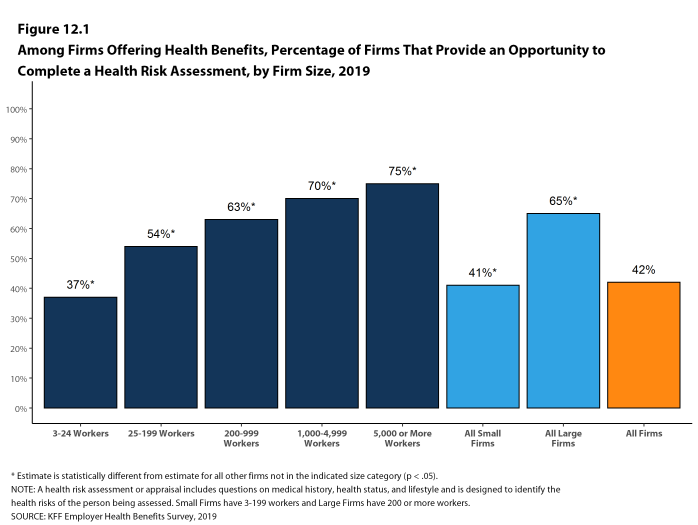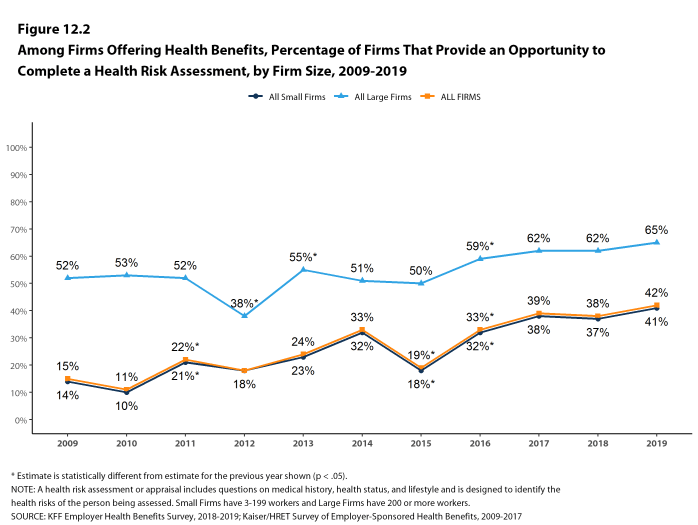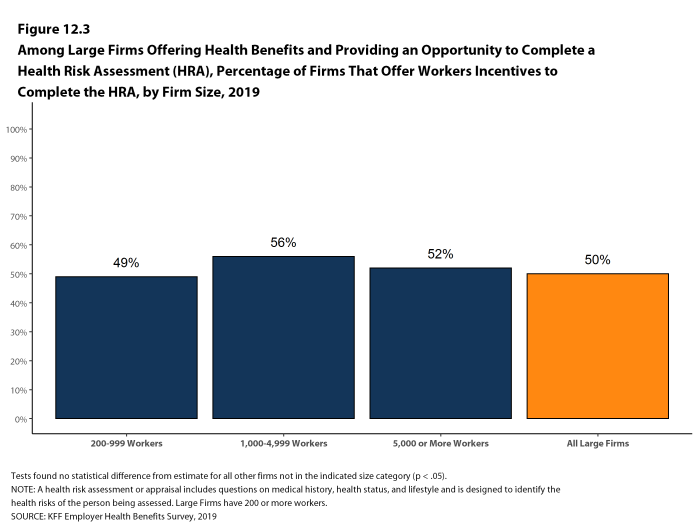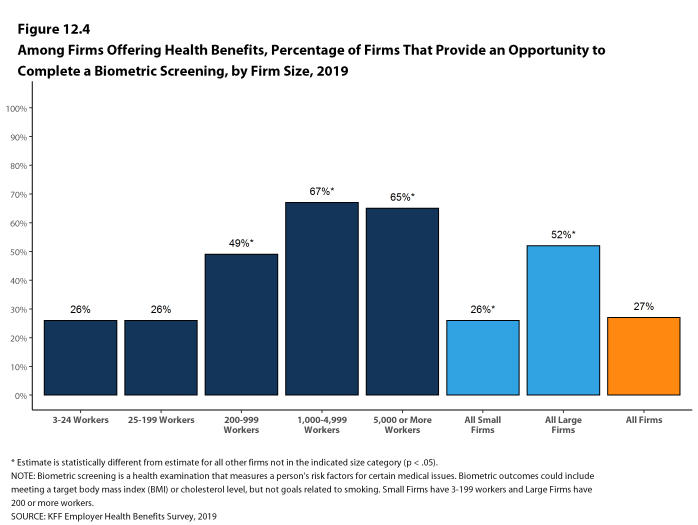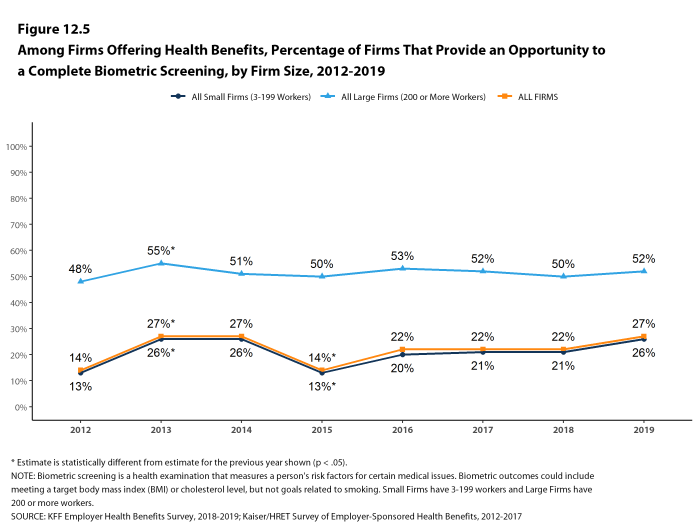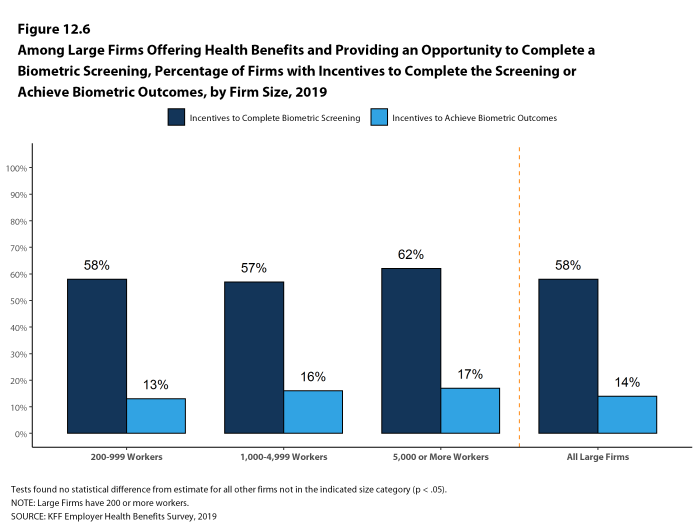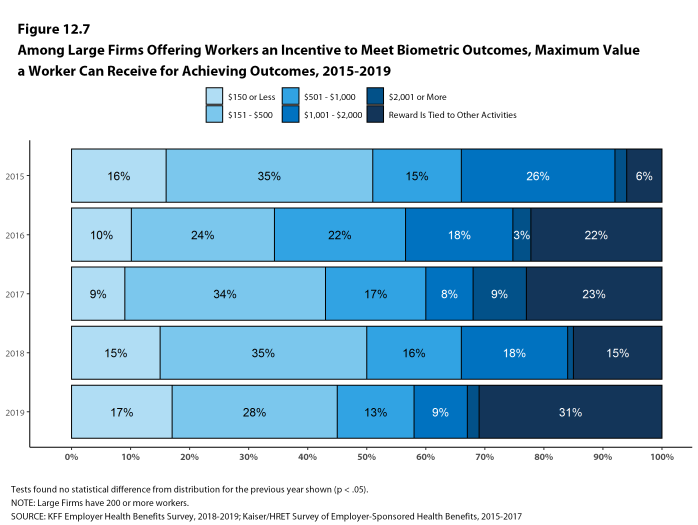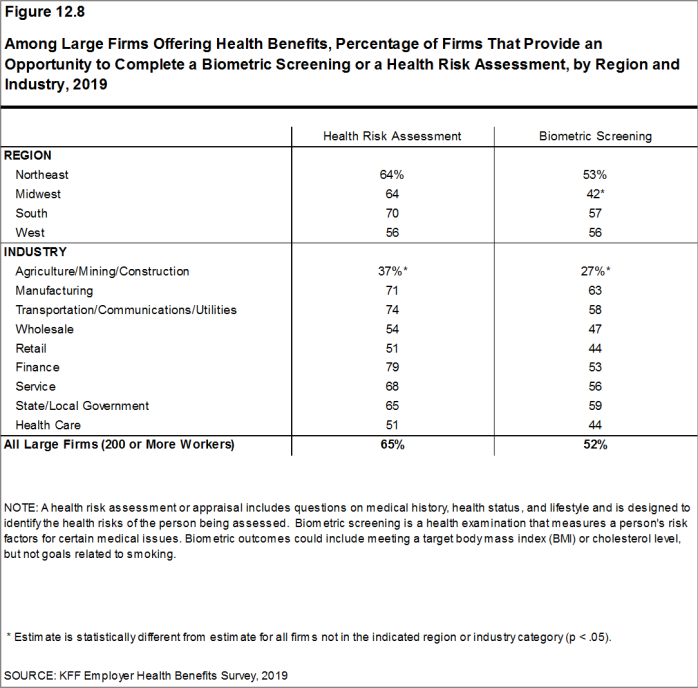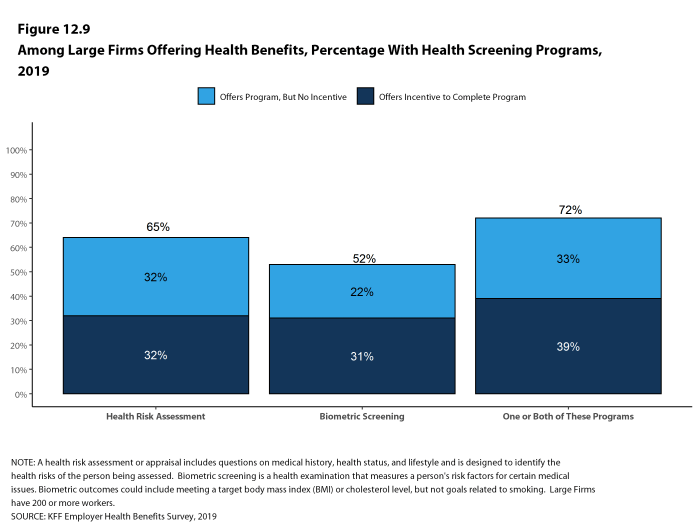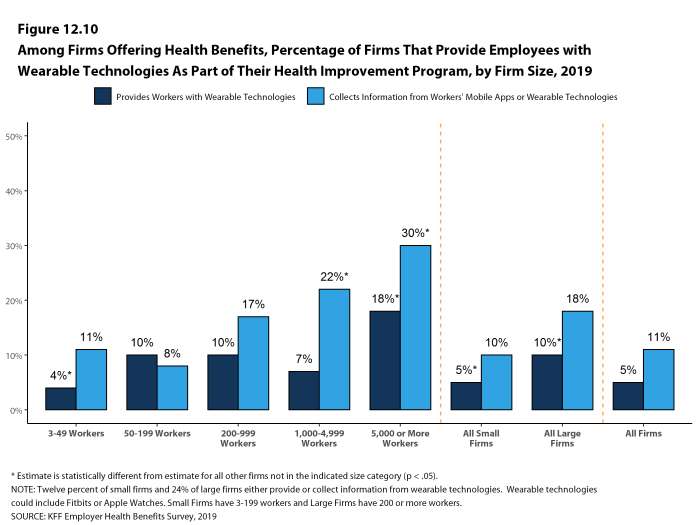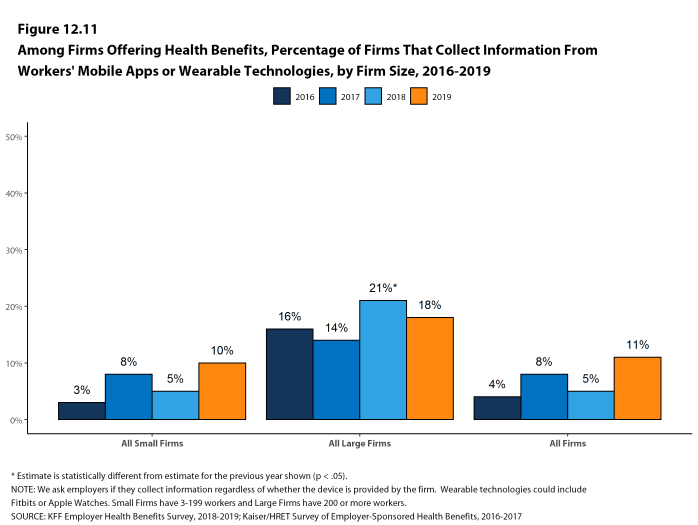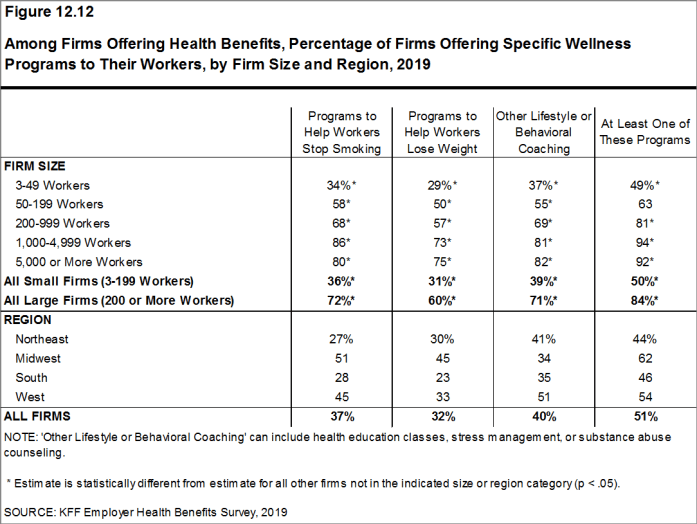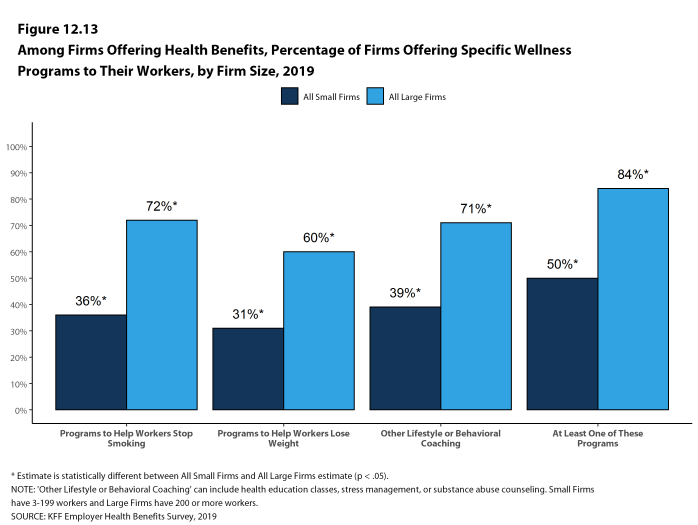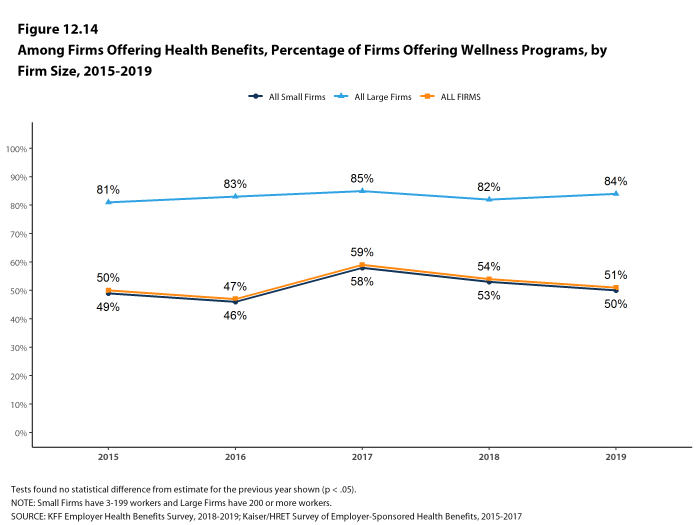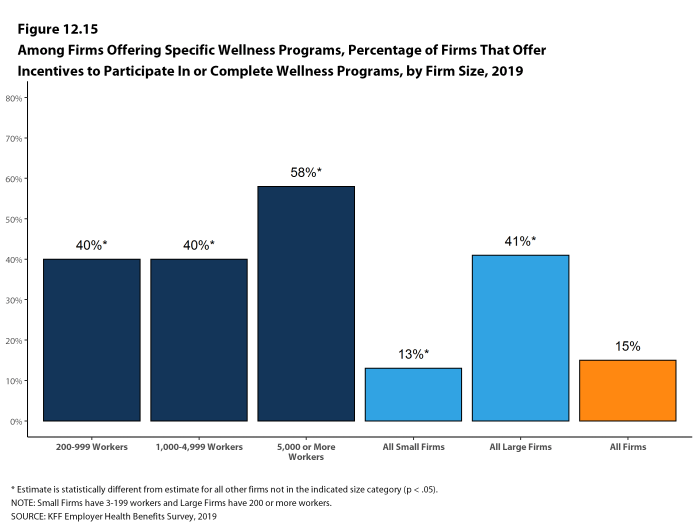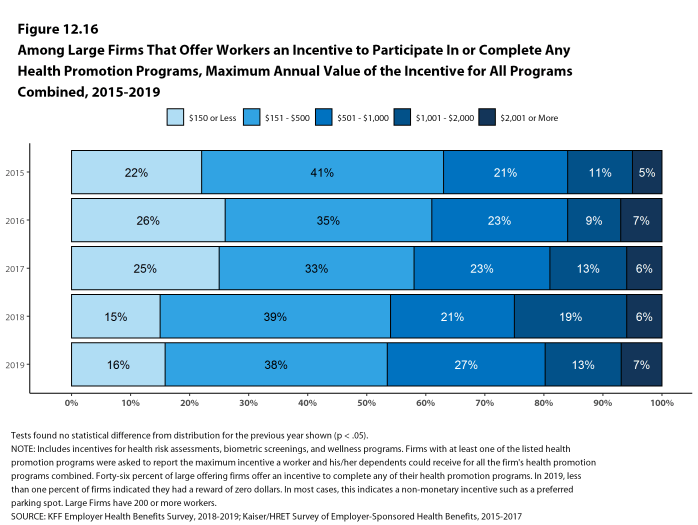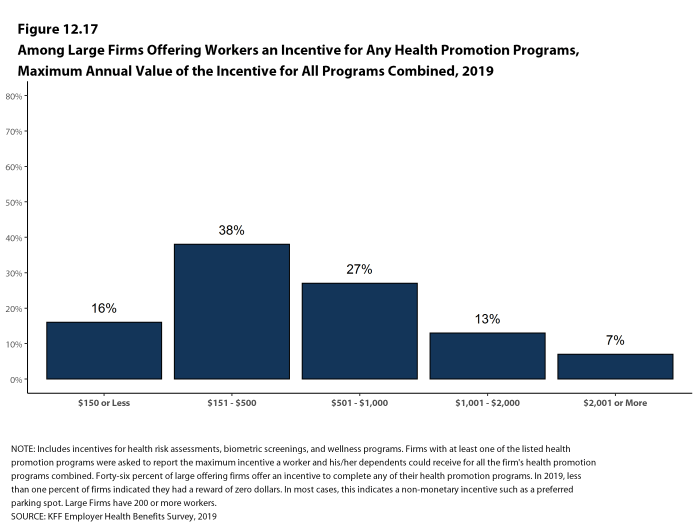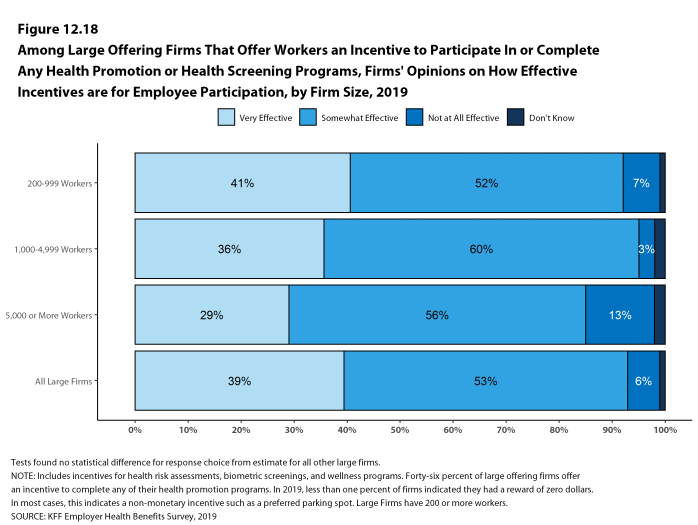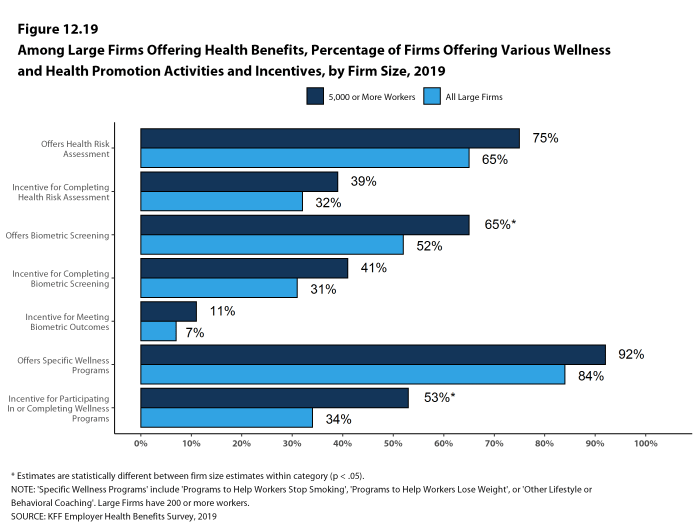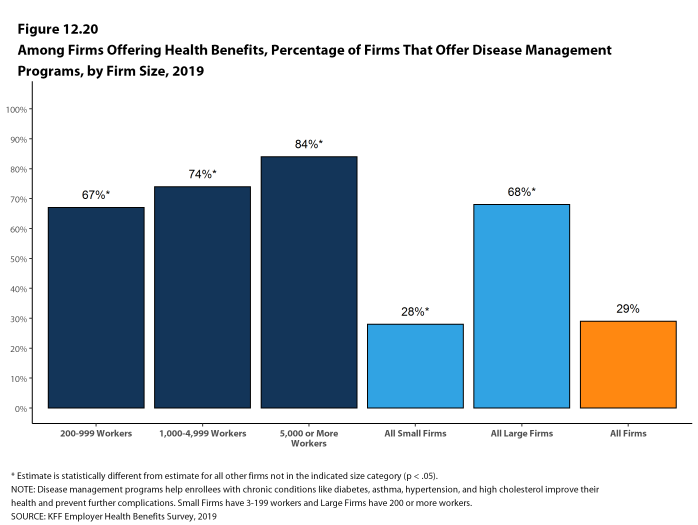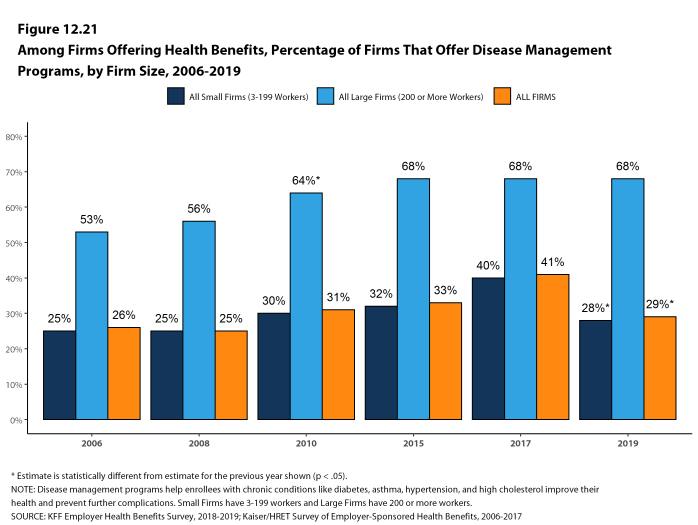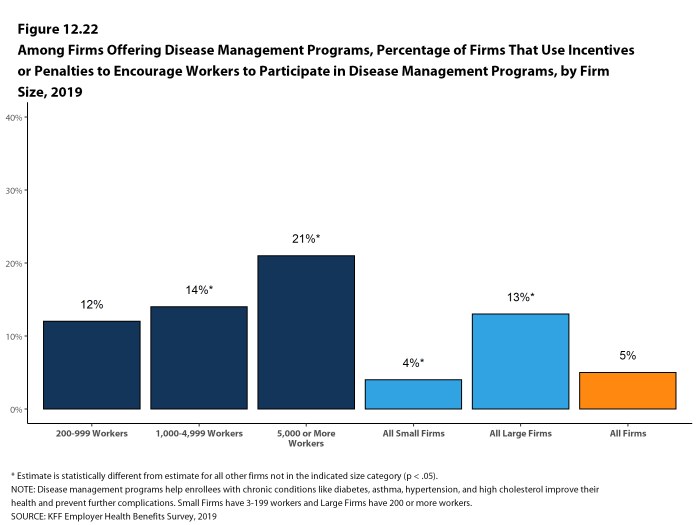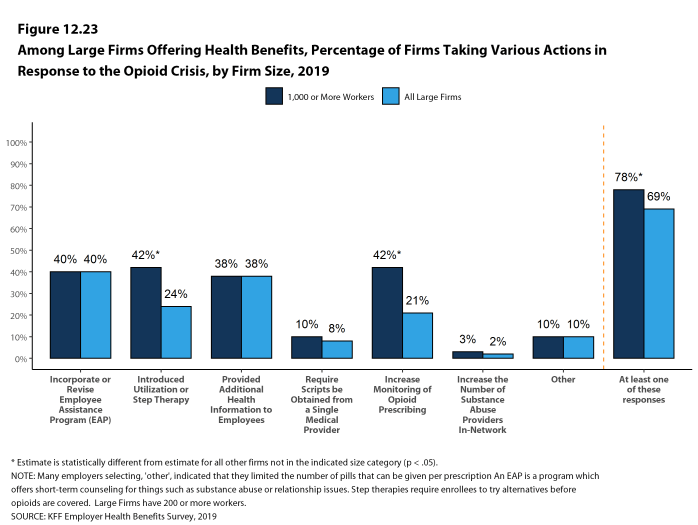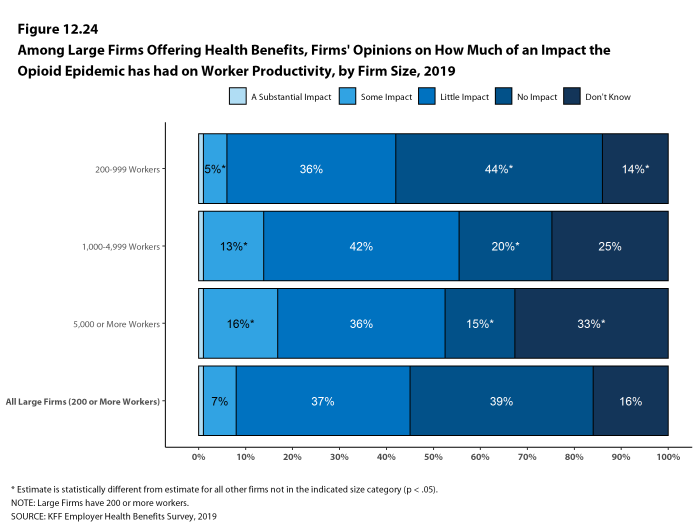2019 Employer Health Benefits Survey
Section 12: Health and Wellness Programs
Firms continue to show considerable interest in programs that help workers identify health issues and manage chronic conditions. Many employers believe that improving the health of their workers and their family members can improve morale and productivity, and reduce health care costs.
In addition to offering wellness programs, a majority of large firms now offer health screening programs, including health risk assessments, which are questionnaires asking workers about lifestyle, stress, or physical health, and biometric screening, which we define as in-person health examinations conducted by a medical professional. Firms and insurers may use the health information collected during screenings to target wellness offerings or other health services to workers with certain conditions or behaviors that pose a risk to their health. Some firms have incentive programs that reward or penalize workers for different activities, including participating in wellness programs or completing health screenings.
Among large firms offering health benefits in 2019, 65% offer workers the opportunity to complete a health risk assessment, 52% offer workers the opportunity to complete a biometric screening, and 84% offer workers wellness programs, such as programs to help them stop smoking or lose weight, or programs that offer lifestyle and behavioral coaching. Substantial shares of these large firms provide incentives for workers to participate in or complete the programs.
Only firms offering health benefits were asked about their wellness and health promotion programs.
Employers, like other institutions, have had to deal with the opioid epidemic that has affected many workers and their family members. Employers have made changes to their health plans and employee assistance programs to address some of the impacts of the epidemic.
HEALTH RISK ASSESSMENTS
Many firms provide workers the opportunity to complete a health risk assessment to identify potential health issues. Health risk assessments generally include questions about medical history, health status, and lifestyle. At small firms, health risk assessments are typically administered by an insurer.
- Among firms offering health benefits, 41% of small firms and 65% of large firms provide workers the opportunity to complete a health risk assessment [Figure 12.1]. These percentages are similar to the corresponding percentages for 2018 (37% for small firms and 62% for large firms) [Figure 12.2]. Over the last decade the percent of large firms offering workers the opportunity to complete a health risk assessment has increased from 52% to 65%.
- Some firms offer incentives to encourage workers to complete a health risk assessment.
- Among firms that offer a health risk assessment, 18% of small firms and 50% offer workers an incentive to complete the assessment [Figure 12.3].
Figure 12.1: Among Firms Offering Health Benefits, Percentage of Firms That Provide an Opportunity to Complete a Health Risk Assessment, by Firm Size, 2019
Figure 12.2: Among Firms Offering Health Benefits, Percentage of Firms That Provide an Opportunity to Complete a Health Risk Assessment, by Firm Size, 2009-2019
BIOMETRIC SCREENING
Biometric screening is a health examination that measures a person’s risk factors (such as cholesterol, blood pressure, and body mass index (BMI) for certain medical issues. A biometric outcome involves assessing whether the person meets specified health targets related to certain risk factors, such as meeting a target BMI or cholesterol level. As defined by this survey, goals related to smoking are not included in the biometric screening questions.
- Among firms offering health benefits, 26% of small firms and 52% of large firms provide workers the opportunity to complete a biometric screening [Figure 12.4]. These percentages are similar to 2018 (21% and 50%) [Figure 12.5].
- Some firms offer incentives to encourage workers to complete the biometric screening.
- Among firms with biometric screening programs, 29% of small firms and 58% of large firms offer workers an incentive to complete the screening [Figure 12.6]. Some firms report offering more than one type of incentive.
- In addition to incentives for completing a biometric screening, some firms offer workers incentives to meet biometric outcomes. Among large firms with biometric screening programs, 14% reward or penalize workers based on achieving specified biometric outcomes (such as meeting a target BMI) [Figure 12.6].
- The size of the incentives firms offer for meeting biometric outcomes varies considerably. Among large firms offering a reward or penalty for meeting biometric outcomes, the maximum reward is valued at $150 or less for 17% of firms and more than $1,000 for 11% of firms [Figure 12.7]. Thirty-one percent of these firms combine the reward with incentives for other activities. This may include employers who ask employees to complete several health screening, disease management, wellness/health promotion activities in order to qualify for incentives.
Figure 12.4: Among Firms Offering Health Benefits, Percentage of Firms That Provide an Opportunity to Complete a Biometric Screening, by Firm Size, 2019
Figure 12.5: Among Firms Offering Health Benefits, Percentage of Firms That Provide an Opportunity to a Complete Biometric Screening, by Firm Size, 2012-2019
Figure 12.6: Among Large Firms Offering Health Benefits and Providing an Opportunity to Complete a Biometric Screening, Percentage of Firms With Incentives to Complete the Screening or Achieve Biometric Outcomes, by Firm Size, 2019
Figure 12.7: Among Large Firms Offering Workers an Incentive to Meet Biometric Outcomes, Maximum Value a Worker Can Receive for Achieving Outcomes, 2015-2019
HEALTH SCREENING PROGRAMS
Among firms offering health benefits, 48% of small firms and 72% of large firms offer workers a health risk assessment, biometric screening or both screening programs.
- Thirty-nine percent of large firms offering health benefits have an incentive for workers to complete a biometric screening or health risk assessment [Figure 12.9].
WEARABLE TECHNOLOGY
Some employers and health plans incorporate information collected from mobile phone applications of wearable devices, such as Fitbits or Apple Watches into their health promotion programs.
- Among all firms offering health benefits, 11% collect information from workers’ mobile apps or wearable devices, such as a Fitbit or Apple Watch, as part of their wellness or health promotion program, similar to the percentage last year [Figure 12.10] and [Figure 12.11].
- Firms with 1,000 to 4,999 and firms with 5,000 or more employees are more likely than other firms to collect information from workers’ mobile apps or wearable devices [Figure 12.10].
- Five percent of employers offering health benefits, including 18% of employers with 5,000 or more employees, provide employees with wearable technologies such as a Fitbit or Apple Watch as part of a health improvement program [Figure 12.10].
Figure 12.10: Among Firms Offering Health Benefits, Percentage of Firms That Provide Employees With Wearable Technologies As Part of Their Health Improvement Program, by Firm Size, 2019
WELLNESS AND HEALTH PROMOTION PROGRAMS
Large shares of employers continue to offer educational and other programs to help workers engage in healthy lifestyles and reduce health risks. Wellness and health promotion programs may include exercise programs, health education classes, health coaching, and stress-management counseling. These programs may be offered directly by the firm, an insurer, or a third-party contractor.
- Among firms offering health benefits, 36% of small firms and 72% of large firms offer programs to help workers stop smoking or using tobacco, 31% of small firms and 60% of large firms offer programs to help workers lose weight, and 39% of small firms and 71% of large firms offer some other lifestyle or behavioral coaching program. Overall, 50% of small firms and 84% of large firms offering health benefits offer at least one of these three programs [Figure 12.12] and [Figure 12.13].
- Forty-one percent of large firms offering one of these wellness or health promotion programs offer an incentive to encourage workers to participate in or complete the programs [Figure 12.15]
Figure 12.12: Among Firms Offering Health Benefits, Percentage of Firms Offering Specific Wellness Programs to Their Workers, by Firm Size and Region, 2019
Figure 12.13: Among Firms Offering Health Benefits, Percentage of Firms Offering Specific Wellness Programs to Their Workers, by Firm Size, 2019
Figure 12.14: Among Firms Offering Health Benefits, Percentage of Firms Offering Wellness Programs, by Firm Size, 2015-2019
INCENTIVES FOR WELLNESS AND HEALTH SCREENING PROGRAMS
Firms with incentives for health risk assessments, biometric screenings, or wellness or health promotion programs were asked to report the maximum reward or penalty a worker could earn for all of the firm’s health promotion activities combined. Some firms do not offer incentives for individual activities, but offer rewards to workers who complete a variety of activities.28 Among large firms offering incentives for any of these programs, the maximum value for all wellness-related incentives is $150 or less in 16% of firms and more than $1,000 in 20% of firms [Figure 12.16].
- This year we asked large firms with an incentive to participate in a health promotion or health screening program, how effective they believed these incentives were at increasing employee participation. 39% believed incentives were ‘very effective’ and 53% said ‘somewhat effective’. [Figure 12.16].
Figure 12.16: Among Large Firms That Offer Workers an Incentive to Participate in or Complete Any Health Promotion Programs, Maximum Annual Value of the Incentive for All Programs Combined, 2015-2019
Figure 12.17: Among Large Firms Offering Workers an Incentive for Any Health Promotion Programs, Maximum Annual Value of the Incentive for All Programs Combined, 2019
Figure 12.18: Among Large Offering Firms That Offer Workers an Incentive to Participate in or Complete Any Health Promotion or Health Screening Programs, Firms’ Opinions On How Effective Incentives Are for Employee Participation, by Firm Size, 2019
DISEASE MANAGEMENT
Disease management programs aim to improve health and reduce costs for enrollees with chronic illnesses by educating them about their disease and suggesting treatment options. These programs can help enrollees with conditions such as diabetes, asthma, hypertension, and high cholesterol.
- Among firms that offer health benefits, 28% of small firms and 68% of large firms offer disease management programs [Figure 12.20].
- The likelihood that firms offering health benefits offer disease management programs increases with firm size [Figure 12.20].
- Among large firms with a disease management program, 13% offer incentives or penalties for workers to participate in or complete the programs. This percentage is highest among firms with 5,000 or more workers (21%) [Figure 12.22].
Figure 12.20: Among Firms Offering Health Benefits, Percentage of Firms That Offer Disease Management Programs, by Firm Size, 2019
Figure 12.21: Among Firms Offering Health Benefits, Percentage of Firms That Offer Disease Management Programs, by Firm Size, 2006-2019
OPIOID CRISIS
The opioid epidemic has challenged employers and their workers in a number of ways. Over prescribing and insufficient follow-up with those prescribed pain medications helped fuel the increase in addiction. Large employers offering health benefits were asked about specific actions that they have made in the past five years in response to the opioid epidemic.
- Forty percent of large employers initiated or revised an employee assistance program, 24% modified their health plans to incorporate utilization management or step therapy for opioid use, 38% provided additional health information to employees, 8% require enrollees with high opioid use to obtain prescriptions from only one provider, 21% asked their insurer or PBM to increase monitoring of opioid use, and 2% increased the number of substance abuse providers in their networks [Figure 12.23].
- Large employers were asked about how much the opioid epidemic had affected the productivity of their workforce. Most say that the epidemic had little impact (37%) or no impact (39%) on productivity [Figure 12.24].
- Employers with 200 to 999 employees are more likely than larger employers to say the epidemic had no impact on productivity (44%) [Figure 12.24].
- Employers with 5,000 or more employees were more likely to say that they did not know (33%), while employers with 200 to 999 workers were less likely to say they did not know (14%) [Figure 12.24].
Figure 12.23: Among Large Firms Offering Health Benefits, Percentage of Firms Taking Various Actions in Response to the Opioid Crisis, by Firm Size, 2019
- In 2019, less than one percent of firms indicated that they had an incentive for completing health risk assessments, biometric screenings, or wellness or health promotion programs, but had a maximum incentive of zero dollars. These firms may have non-monetary incentives such as preferred parking spots or employee recognition programs.↩

